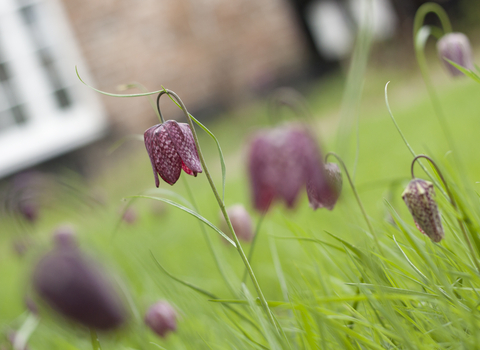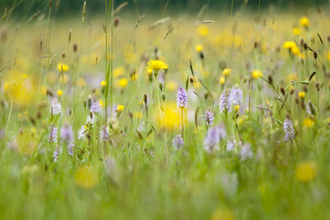Fritillaries
The snake’s-head fritillary blooms in the spring alongside lady’s smock and marsh marigold. Once more widespread the nodding pink and white-chequered blooms, can now only be found in a handful of floodplain meadows in southern and central England. Questions remain about whether this is a truly native species: the first reference to it growing in the wild is as relatively recent as 1736, despite already being known from gardens some 150 years earlier. But whatever its origins, the sight of a field ablaze with the drooping wine-red heads is a sight worth seeing.
Visit one of our special nature havens to see a purple haze of nodding snake’s-head fritillaries
Find a snake’s head fritillary meadow
Do a little research in advance and find out some of the best Wildlife Trust reserves to see snake’s head fritillaries.
Berks, Bucks and Oxon Wildlife Trust
Iffley Meadows: Each April, Iffley Meadows plays host to a wonderful wildlife spectacle where you can enjoy Oxfordshire's iconic flower, the snake's head fritillary, in bloom in its natural surroundings. Wet meadows crossed by old river channels with willow-lined ditches, they contain a rich diversity of wildlife typical of old and unspoilt meadow land. In spring, the blooms of cuckooflower mark the start of a colourful sequence of wild flowers in the meadows. The orange-tip butterfly can be seen fluttering from flower to flower laying its eggs. Later, the yellow of buttercups and the reds and purples of great burnet and knapweed come to the fore.
Herefordshire Wildlife Trust
Lugg Meadow: The great expanses of Upper and Lower Lugg Meadow are unique in Herefordshire, not just for their sheer size but also for being living survivors of a land tenure and farming economy system which has long since disappeared elsewhere. The two special plants of Lugg Meadow are undoubtedly the delicate and attractive fritillary and the nationally scarce narrow-leaved water dropwort. The fritillary population is slowing spreading here with numbers currently reaching over 1,500.
London Wildlife Trust
Camley Street: Two unique acres of wild green space right in the heart of London, this innovative and internationally acclaimed nature reserve on the banks of the Regent's Canal is a great place to spot wild fritillaries – a very rare sight in London. It is likely these were introduced after the reserve was created from an old coal yard back in 1984, but they are still worth enjoying. The reserve now provides natural habitat for birds, butterflies, amphibians and a rich variety of plant life and all next door to King's Cross and St Pancras stations!
Suffolk Wildlife Trust
Mickfield Meadow: A stunning flower-rich hay meadow, Mickfield Meadow has never been sprayed or fertilised. As a result, it is host to abundant wildflowers, many of which are now scarce in Suffolk. The unusual mix of plants growing here is remarkable, with the site being one of four left in Suffolk where the beautiful snake’s head fritillary can still be found. Scattered among these nodding heads in the wetter parts of the meadow is the ragged-robin and meadowsweet. In the drier areas, look for the goldilocks buttercup and the low growing wood anemone.
Martin’s Meadow: Composed of three meadows, Martin’s Meadow is among the few flower-rich hay meadows still left in Suffolk. Managed without spraying, draining and fertilisation, the meadow supports a wide range of wild flowers including the snake's head fritillary. Visit in spring to enjoy superb displays of early-purple, green winged and pyramidal orchids. Visit in summer, and the meadow will be transformed with the pink and purple bloom of meadow saffron. Most of the hedges enclosing the site here at least 100 years old and contain many different species of trees and shrubs, including field maple, hazel, hawthorn and spindle.
Fox Fritillary Meadow is an ancient floodplain and one of the largest of four remaining sites for the snake's-head fritillary in Suffolk. Visiting this meadow is possible by arrangement only. Visit between mid April to early May to awe at impressive displays of up to 300,000 nodding purple-chequered and white flower heads. Blooming alongside these are early meadow flowers including cowslip and cuckoo.
Wiltshire Wildlife Trust
Clattinger Farm: A precious remnant of Britain’s hay meadows, Clattinger Farm is considered the finest remaining example of enclosed lowland grassland in the UK. A Site of Specific Scientific Interest (SSSI), the reserve is particularly important for its extremely rare hay meadow wildflowers, including fritillaries. Visit in late April to adore the fragile, nodding heads of the snake's head fritillary, and spot other treasures including the downy-fruited sedge, and nationally scarce burnt orchid. Other interesting wild plants here include early purple and southern marsh orchids, tubular water-dropwort, adder’s tongue fern and great burnet.
What to look for
The snake’s-head fritillary is a flower of damp riverside hay meadows, with orange tip butterflies fluttering by, the newly-returned willow warbler singing from the riverbank and a cuckoo declaring from the willow trees. Its favoured meadows may be few and far between, but where it does grow it often grows in great profusion, Visit in the morning, or towards the close of play, to get the best views of the flowers when they are back-lit by the sun and glowing berry-red.
If you can't get to these places
Hay meadows are amongst the most endangered habitats in the country, and you are lucky indeed if you live near to a flower-rich grassland. The Berks, Bucks & Oxon Wildlife Trust (BBOWT), which manages Iffley Meadows has a great selection of photos of the fritillaries on its flickr account, as well as other wildlife spotted on its nature reserves. Have a browse here.
More wildlife experiences
From seeing colourful wildflowers to spotting magnificent birds of prey, we can help you get closer to wildlife across the UK.





